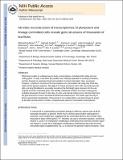| dc.contributor.author | Guttman, Mitchell | |
| dc.contributor.author | Garber, Manuel | |
| dc.contributor.author | Levin, Joshua Z. | |
| dc.contributor.author | Donaghey, Julie | |
| dc.contributor.author | Robinson, James | |
| dc.contributor.author | Adiconis, Xian | |
| dc.contributor.author | Fan, Lin | |
| dc.contributor.author | Koziol, Magdalena J. | |
| dc.contributor.author | Gnirke, Andreas | |
| dc.contributor.author | Nusbaum, Chad | |
| dc.contributor.author | Rinn, John L. | |
| dc.contributor.author | Regev, Aviv | |
| dc.contributor.author | Lander, Eric Steven | |
| dc.date.accessioned | 2012-10-12T18:54:20Z | |
| dc.date.available | 2012-10-12T18:54:20Z | |
| dc.date.issued | 2010-07 | |
| dc.date.submitted | 2010-03 | |
| dc.identifier.issn | 1087-0156 | |
| dc.identifier.issn | 1546-1696 | |
| dc.identifier.uri | http://hdl.handle.net/1721.1/73946 | |
| dc.description | available in PMC 2010 November 2. | en_US |
| dc.description.abstract | RNA-Seq provides an unbiased way to study a transcriptome, including both coding and noncoding
genes. To date, most RNA-Seq studies have critically depended on existing annotations,
and thus focused on expression levels and variation in known transcripts. Here, we present
Scripture, a method to reconstruct the transcriptome of a mammalian cell using only RNA-Seq
reads and the genome sequence. We apply it to mouse embryonic stem cells, neuronal precursor
cells, and lung fibroblasts to accurately reconstruct the full-length gene structures for the vast
majority of known expressed genes. We identify substantial variation in protein-coding genes,
including thousands of novel 5′-start sites, 3′-ends, and internal coding exons. We then determine
the gene structures of over a thousand lincRNA and antisense loci. Our results open the way to
direct experimental manipulation of thousands of non-coding RNAs, and demonstrate the power
of ab initio reconstruction to render a comprehensive picture of mammalian transcriptomes. | en_US |
| dc.description.sponsorship | Merkin Family Foundation for Stem Cell Research | en_US |
| dc.description.sponsorship | Howard Hughes Medical Institute | en_US |
| dc.description.sponsorship | National Human Genome Research Institute (U.S.) | en_US |
| dc.description.sponsorship | Burroughs Wellcome Fund | en_US |
| dc.description.sponsorship | Broad Institute | en_US |
| dc.language.iso | en_US | |
| dc.publisher | Nature Publishing Group | en_US |
| dc.relation.isversionof | http://dx.doi.org/10.1038/nbt.1633 | en_US |
| dc.rights | Creative Commons Attribution-Noncommercial-Share Alike 3.0 | en_US |
| dc.rights.uri | http://creativecommons.org/licenses/by-nc-sa/3.0/ | en_US |
| dc.source | PMC | en_US |
| dc.title | Ab initio reconstruction of transcriptomes of pluripotent and lineage committed cells reveals gene structures of thousands of lincRNAs | en_US |
| dc.title.alternative | Ab initio reconstruction of cell type–specific transcriptomes in mouse reveals the conserved multi-exonic structure of lincRNAs | en_US |
| dc.type | Article | en_US |
| dc.identifier.citation | Guttman, Mitchell et al. “Ab Initio Reconstruction of Cell Type–specific Transcriptomes in Mouse Reveals the Conserved Multi-exonic Structure of lincRNAs.” Nature Biotechnology 28.5 (2010): 503–510. Web. | en_US |
| dc.contributor.department | Massachusetts Institute of Technology. Department of Biology | en_US |
| dc.contributor.mitauthor | Guttman, Mitchell | |
| dc.contributor.mitauthor | Lander, Eric S. | |
| dc.contributor.mitauthor | Regev, Aviv | |
| dc.relation.journal | Nature Biotechnology | en_US |
| dc.eprint.version | Author's final manuscript | en_US |
| dc.type.uri | http://purl.org/eprint/type/JournalArticle | en_US |
| eprint.status | http://purl.org/eprint/status/PeerReviewed | en_US |
| dspace.orderedauthors | Guttman, Mitchell; Garber, Manuel; Levin, Joshua Z; Donaghey, Julie; Robinson, James; Adiconis, Xian; Fan, Lin; Koziol, Magdalena J; Gnirke, Andreas; Nusbaum, Chad; Rinn, John L; Lander, Eric S; Regev, Aviv | en |
| dc.identifier.orcid | https://orcid.org/0000-0001-8567-2049 | |
| mit.license | OPEN_ACCESS_POLICY | en_US |
| mit.metadata.status | Complete | |
